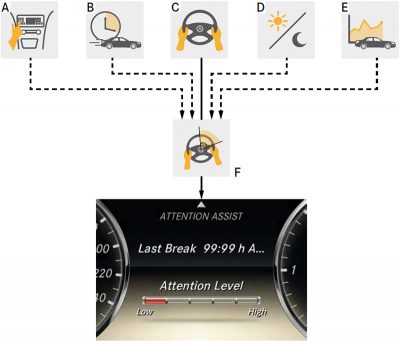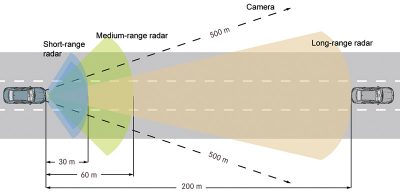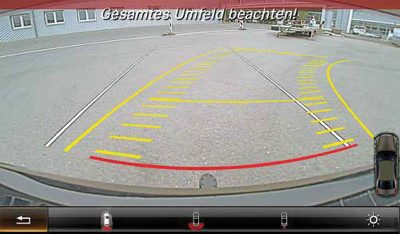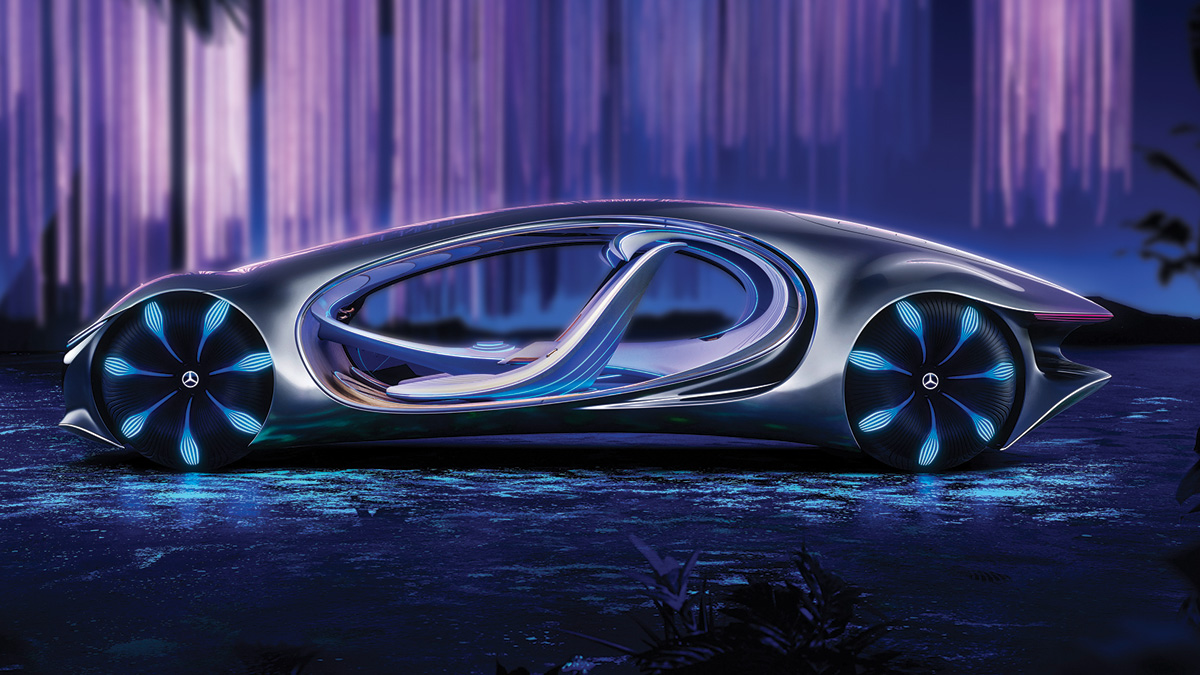Helping the driver down the road to autonomous
While it may be rare for you to get a customer complaint about a Mercedes-Benz assist system – they are so darn reliable – in anticipation of that day, we’ll offer an overview of the various systems available. After all, if you don’t know what it does, how can you repair it?
Assist systems are designed to help the driver and enhance safety, either by making the drive more comfortable to relieve stress on the driver, or to support the driver in critical situations. While many assist systems offer active intervention, most are providing information and support to the driver as he or she makes decisions on the road.
One issue you will encounter is that nearly every assist system has, at one time or another, had its name changed. We’re going to focus on vehicles that are a few years old, ones that you are most likely to see in your shop, and we’ll be using the names and terminology of that time period. In any case, if you want to know what any assist system in any particular vehicle is called and what it does, your absolutely best resource is the owners manual. If that manual is missing from your customer’s car, either visit MBUSA.com for manuals back to 2012, or log in to StarTekInfo.com for manuals dating back to 2001 and, for most models, even earlier. Also at StarTekInfo.com are two “Introduction to Service†books covering Assist Systems in great detail.
The very first driver assist system, introduced by Mercedes-Benz in the early 1980s, was ABS, the Anti-lock Braking System. This prevented the wheels from locking up under heavy braking, preventing the loss of directional control. Anyone who could literally just stomp on the brake pedal could enjoy controlled braking at least as good as the very best drivers on the planet.
This was followed by ASR, Acceleration Slip Regulation, which did for acceleration what ABS did for braking: control wheel slip and its resulting loss of directional control during acceleration. Thus, anyone who could stomp on the accelerator pedal could maintain control of the vehicle, since ASR kept the rear wheels from slipping.
These two systems were later enhanced by ESP, the Electronic Stability Program. While ABS and ASR are mainly effective when driving in a straight line, ESP operates primarily when the vehicle is turning. Using a combination of sensors, the system first determines where the driver wants the vehicle to go, and compares that to where the vehicle is actually going. If these differ, ESP brakes a single wheel in an effort to pivot the vehicle back onto course. Naturally, the system is somewhat more complex than this, and, also naturally, it can’t overcome the laws of physics: Enter the curve too fast, or lose too much traction, and the system won’t be as effective as the driver might want.
But these older systems are fairly well-known and understood, and so we won’t go into more details about them here. Instead, we’re going to look at the newer systems so that they become just as familiar as good old ABS.
Attention Assist

Attention Assist is a standard feature in virtually all models since around 2013. The ESP module monitors several vehicle parameters using existing sensors to help identify a tired or inattentive driver, and signals the need for a break. The most important factors in evaluating driver tiredness are steering wheel angle changes, time of day, and length of journey, although active vehicle operation (pressing radio buttons, for example) are also considered as indications the driver is alert.
During the first 20 minutes of a drive, the system determines the driver’s profile. When the system detects a deviation from this profile that may point to drowsiness or inattentiveness, such as quick, jerky steering movements, it issues a visible and audible warning, via the instrument cluster. Note that no new systems or components are used for Attention Assist: All the signals come from existing sensors. The system can be deactivated from the instrument cluster via the assist systems menu.
As of Models 207 and 212, Attention Assist has an additional higher-sensitivity mode that the driver can select.
Lane Keeping Assist

The Lane Keeping Assist system uses a camera in the windshield to detect lane markings and warn the driver when the vehicle starts to leave its travel lane. As a warning, the steering wheel is vibrated, to simulate road-edge rumble strips. The driver activates this function via the instrument cluster, and can select either ‘standard’ or ‘adaptive’ mode.
In standard mode, warnings are suppressed if the driver uses the turn signal, or if ABS, ASR or ESP are actively operating. In Adaptive mode, warnings are additionally suppressed if the driver actively counter-steers or switches lanes, brakes or accelerates, or cuts a corner.
The system is also available as an active system in some models. Here, the vehicle uses asymmetric braking – applying the brakes on one side of the vehicle only – to pull the vehicle back into its lane. This action is very noticeable by the driver and also serves as a warning. It is relatively gentle and can easily be overcome by the driver using the steering wheel.
With this system, active lane corrections are suppressed if, for example, the system detects an object (such as a vehicle) that might be in the way if a correction is made, or in a sharp curve. The system is designed to operate above moderate speeds and not during slow maneuvers. Calibration of the camera is required, which we’ll discuss later in this article.
Blind Spot Assist

Blind Spot Assist uses radar sensors in the rear sides to detect objects in the driver’s blind spots at speeds above about 20 MPH. If an object is detected, the system lights up a red LED in the appropriate exterior mirror. If the driver signals an intent to change lanes while an object is detected, a warning tone sounds and the red LED flashes. If the system is not ready, for example at low speeds, the mirror LEDs light yellow.
A short-range radar sensor inside each side of the rear bumper is used to detect objects. Not all objects can be detected, or detected in a timely manner: Fast-overtaking vehicles, or poor radar targets like a motorcycle may not be detected. Also note that the radar sensors are sensitive to certain (especially metallic) coatings on the bumper, as well as imperfections (such as heavy grinding marks) on the inside surface of the bumper cover. The sensors require no calibration, but must be firmly clipped into their holders.
As with Active Lane-Keeping Assist, Mercedes-Benz also offers Active Blind Spot Assist. Again, the vehicle brakes are used to nudge the vehicle away from a detected object. The lane correction is again suppressed under certain circumstances, particularly at high speeds, if the driver steers or accelerates, and in sharp curves.
PARKTRONIC®

PARKTRONIC® uses ultrasonic sensors, which don’t require calibration, positioned in the front and rear bumpers to indicate to the driver the distance to any detected objects. An LED display is used to show the driver the approximate distance to a detected object, along with an intermittent tone that sounds more frequently as the distance narrows. Poor installation of the sensor, overly thick paint coatings, or deteriorated isolation rings around the sensor can cause erratic operation.
The Park Assist function further expands PARKTRONIC by identifying potential parking spaces and, if the driver takes action, actually parking the vehicle in the identified space. Early systems could detect and park in parallel spaces only, and required the driver to control the brake and throttle. Later systems can also detect perpendicular (straight-in) spaces and back the car into one, controlling brakes and throttle along with steering, so the driver only has to initiate the parking maneuver and wait for it to be completed.
The system can also un-park the vehicle, if it was parked using the system. After all, if you are having trouble parallel parking, you might also have trouble pulling back into traffic. As expected, the system only operates at low speeds. The instrument cluster provides instruction to the driver, including a caution to verify that the identified location really is a parking space. And no, it can’t prevent a ticket for violating parking restrictions.
DISTRONIC PLUS

DISTRONIC PLUS is a convenience-oriented system that maintains a set following time from a vehicle ahead. If there is no vehicle ahead detected by the radar sensors, the system operates like normal cruise control, maintaining a set speed.
If a vehicle ahead slows down, DISTRONIC PLUS will also slow the vehicle, all the way down to a stop if necessary. Restarting requires the driver to either accelerate or tap the cruise control lever. The older DISTRONIC system (without the plus) does not operate below about 20 MPH. Note that the braking rate of the system is limited, and so this is not an accident prevention system: The driver must remain alert and react to the driving situations.
The system operates with short-, medium- and long-range radar sensors mounted in front, and the camera mounted to the windshield. You can usually tell which models have DISTRONIC by looking at the star in the grille. Earlier systems used sensors that required aiming using a special tool and aiming target, while later systems are self-calibrating, requiring a test drive of several minutes.
Night Vision Assist

This system uses a forward-facing infra-red (IR) camera, along with additional front lamps that emit only infra-red light in a pattern similar to high beams, to display an image of the road ahead to the driver. Infra-red light doesn’t dazzle other drivers, meaning much more light can be projected ahead. The later system, NVA+, is designed to identify and highlight pedestrians and larger animals on the display. Mercedes-Benz recommends against operating the vehicle by watching only the display, but the display clarity is remarkable.
The IR light is delivered by regular H7 headlight bulbs covered by a special IR filter. The system is switched off in daytime, and at a standstill for safety: Looking into the IR light beam can hurt your eyes, since the amount of energy is about the same as a headlamp, but your eyes don’t react to IR light. The camera is mounted either in the front grille or the windshield. Any time work is performed on or near the camera, recalibration is required.
Visible light cameras

While not a single Assist System, we wanted to close this article with an introduction to the cameras in and around the vehicle. Used for multiple systems, these wonders of technology sometimes need some special care.
The mono multipurpose camera (MPC) is used for the Lane-Keeping Assist system, for example, to detect lane markings ahead of the vehicle. A system known as Traffic Sign Assist also uses this camera to detect road signs such as speed limit and stop signs.
More advanced is the stereo multipurpose camera (SMPC), which has two cameras mounted to the windshield several inches apart. One system that uses the SMPC is Cross-Traffic Assist with Pedestrian Protection. This system is designed to detect objects moving across the vehicle’s path, such as a vehicle at an intersection or a pedestrian, and warn the driver or actively brake the vehicle if a collision is calculated. Another system, Magic Carpet, is a suspension system that uses the SMPC to detect and react to road imperfections, delivering a ride so smooth it’s like riding on, well, a magic carpet. The SMPC is also used for the same functions as the MPC.
Then there are the reversing camera and the Surround View cameras. The reversing camera is mounted at the rear of the vehicle, sometimes behind a motorized cover. When the vehicle is shifted into reverse, the camera activates and shows the view behind the vehicle on the head unit screen. In some models, lines are superimposed on the display to help the driver better gauge the path and size of the vehicle. The reversing camera can be disabled in the head unit, so if it’s not working, verify it is enabled.
Surround View is a system that displays a 360 degree view around the vehicle at low speeds. Extremely useful for low-speed maneuvering, the view is displayed on the audio head unit screen. The driver can select several possible viewpoints, including birds-eye (a virtual viewpoint several yards above the vehicle), surround, and left/right flank. In addition to the reversing camera, three more cameras (one in the front grille, and one beneath each door mirror) deliver their images to the head unit, which shapes the view as selected by the driver.
The windshield-mounted cameras all require calibration after they or the windshield is replaced. Almost always this requires the use of a vision target and XENTRY Diagnostics. The camera mounting bracket is permanently adhered to the glass and cannot be removed or replaced. Make sure no dirt or smudges are on the glass when mounting the camera.
The reversing camera and Surround View cameras generally also require calibration, but different versions of the system use different methods. Check in WIS or XENTRY Diagnostics for the details. The entire system must be calibrated even if only a single camera or camera holder (e.g. side mirror) is replaced.
For all cameras, the video is delivered through special video cables. These cables cannot be repaired if damaged, but replacements are generally available.

Limitations on space prevent us from delving into many other assist systems, because Mercedes-Benz offers so many. Some of these systems are remarkable: Steering the vehicle down the road, fully-autonomous braking, compensating for cross winds, supporting emergency braking, automatically handling stop-and-go traffic, and more. As with ABS, which brings the braking ability of the average driver to a point beyond that of even the best drivers, these assist systems are laying the groundwork for the fully-automated self-driving cars of the future. While we at StarTuned can’t predict when such a vehicle will be offered for sale, we are convinced that Mercedes-Benz will be among the first to do so.
Download PDF





0 Comments